The Hottest Hit On The Planet:

“I Got You Babe”
by Sonny & Cher
“Dylan had “babe” all over the airwaves, you know, so I thought “babe”, “babe”, there’s got to be something to use with that “babe.” And, uh, I took that, and then just added the “I got you” part to it…”
That’s Sonny Bono in Dancing In The Streets:
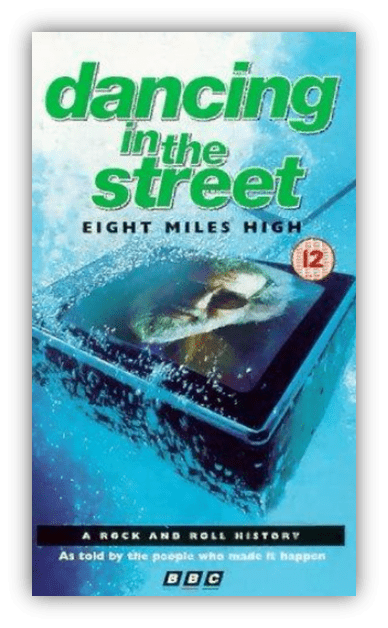
Everyone’s favourite rock’n’roll BBC documentary from 1996.
He doesn’t go on to mention whether he took the “I got you” part from James Brown – is “I Got You Babe” just a Dylan/James Brown mashup? – but it doesn’t matter. Of all the lame-ass attempts at being the next Dylan, Sonny Bono’s might be the lamest-assiest.
Sonny spoke in a voice almost as nasally as the one Dylan uses when he sings, presumedly another reason for Sonny to jump aboard the Dylan train.
A lot of people seemed to be jumping aboard the Dylan train at the time. But in terms of being a shameless pop-friendly Dylan rip-off, “I Got You Babe” is far more shameless than something like Barry McGuire’s much-ridiculed “Eve Of Destruction.”
At least Barry was trying to write poetry, trying to make it mean something, trying – way too hard – to sing.

And at least he wasn’t trying to sing like Dylan. Who was Barry aiming for anyway? It wasn’t as though Joe Cocker existed yet. Barry sounded, and looked, as though he was channeling the pain of a construction worker who had just dropped a wrench on his toe.
Sonny Bono on the other hand, was simply some clown trying to write a song with the word “babe” in the title.
Sonny Bono’s Dylan-fandom seemed to go only as far as liking his voice… because he figured that if Bob Dylan’s nasal drone could get on the radio, then maybe his own nasal drone would be in with a chance!
Most of the pop stars who tried to rip Dylan off were folkies. Sonny was not a folkie.
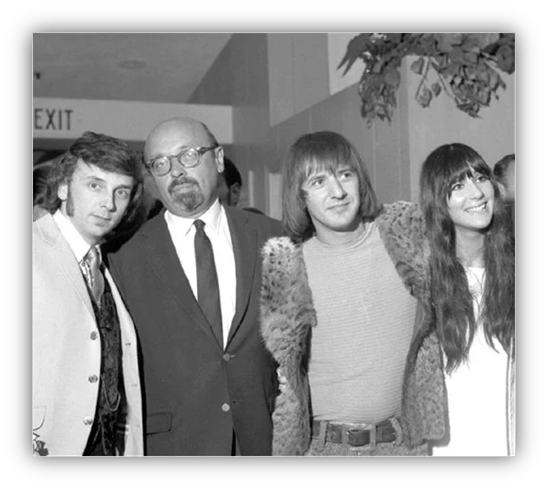
Sonny was hanging out with Phil Spector, writing pop hits, writing “Needles & Pins.”
Sonny made a lot of records with Phil Spector. One might argue that “I Got You Babe” represents Phil Spector production techniques with the nascent proto-hippie aesthetic pasted on top (although, let’s face it, no Phil Spector production would ever be this dinky). For if not a folkie exactly, Sonny certainly seemed to think of himself as some sort of beatnik hippie.

Or at least he dressed like one.
And he didn’t just dress up like that for television and photo opportunities. That’s the way Sonny Bono always dressed. Sonny was dressed that way the night he met Cher. He was wearing “a black mohair suit and a mustard shirt with a white collar and Cuban boots”, which sounds utterly horrid.
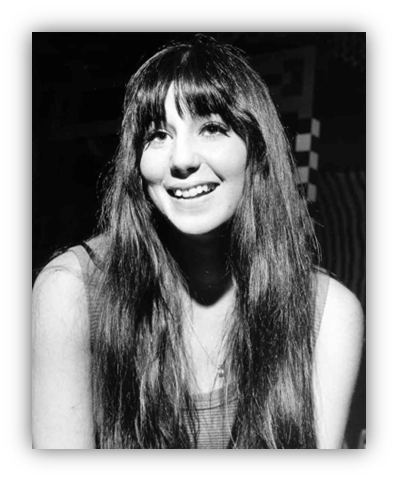
Cher, 16, although she told everyone she was older, had a boyfriend called Red, who definitely was older, and…
“One day Red told me, ‘I have a great friend who just split up with his wife. He’s a weird guy, but he’s a lot of fun, and everyone loves him. Maybe you could introduce him to your roommate, and we could double-date.“
“So we all decided to meet. One afternoon at Aldo’s Coffee Shop, a hangout for radio people and disc jockeys who worked next door at KFWB, Red and I sat down at a table with Melissa, my roommate. Then someone came in, and everybody turned around. The room started buzzing – ‘Sonny’s here! ‘Hey, Son!’ “

And, for Cher anyway, it was – inexplicably – love at first sight.
Sonny and Cher danced together that night, mostly because Red and Melissa refused to. This was a bit of a bummer for Sonny, since he considered Melissa to be the hot one. I can’t find a photo of her, but Melissa being hot is a subject upon which everyone seems to agree. Also that she was a lesbian, so Sonny lucked out there.
Then, in a move that wasn’t creepy at all, Sonny moved into their apartment block. Of all the apartment blocks in L.A.
Sonny totally wasn’t stalking Melissa (obviously I don’t know whether he was or not, but it kind of sounds like it, doesn’t it?). Next thing you know Melissa is kicking Cher out of her flat, and Cher, suddenly a homeless teenage vagabond, knocks on Sonny’s door, asking for somewhere to stay.
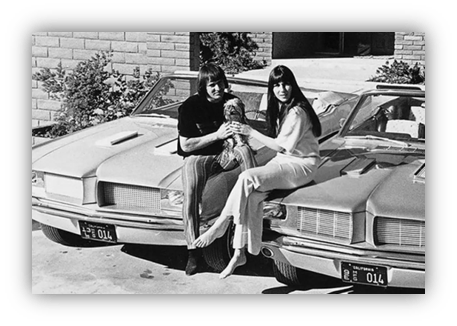
Sonny asks if she can cook and clean. Cher says yes. This, like virtually everything that Cher told Sonny – most notably her age – was a lie.
Sonny says, “sure you can stay with me then, I don’t find you particularly attractive,” because the man is a gentleman.
“I Got You Babe” begins with the immortal words, “they say we’re young.” Nobody ever said Sonny Bono was young. He was 30.
It’s at this point that “I Got You Babe” turns out to be “based on a true story:
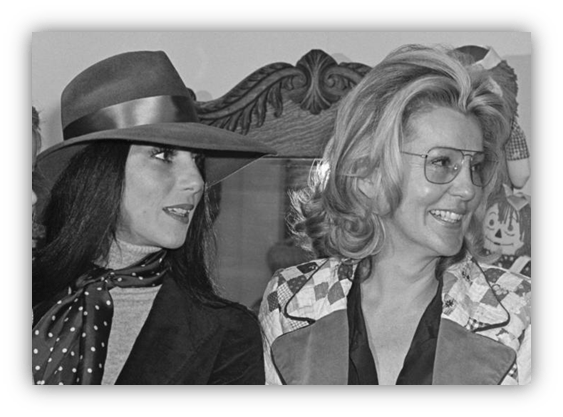
Since Cher’s mother, generally regarded as one of the worst mothers in pop, wakes up to what’s going on and forces Cher back home.
And this is the point when Sonny, upon discovering that he no longer has a cleaner – not that Cher did much of that, but anyway – decides that he does find her particularly attractive.
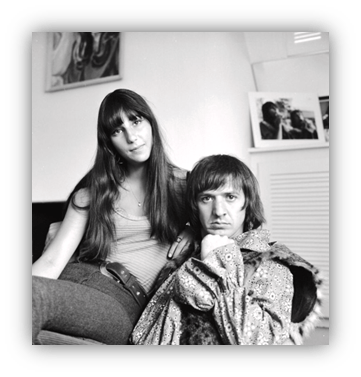
So Sonny got Cher to wear his ring; one he bought at an Indian souvenir shop before they got married in a bathroom in Tijuana.
Still, together they made a cute, if not necessarily happy looking, couple.
Together they wore ridiculous outfits, and Cher rolled her eyes at him a lot.
And often looked as though she wished she could – BANG! BANG! – shoot him down.

And they were a cute couple. Here’s Cher being sad and Sonny being some sort of caveman-clown hybrid.
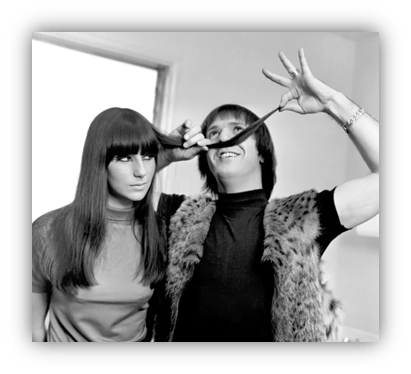
(Looking at all the photos of Sonny, he wore that caveman coat A LOT!!! I do hope he washed it.)
Just watch them turning to each other every time they sing “babe”, which, even in this truncated version, is quite a lot. In the complete version they say it 14 times, plus one “baby.” That might be more than Dylan’s entire collected works (it’s not, but it feels as though it might)

Sonny followed “I Got You Babe” with an even more shameless Dylan rip-off.
No doubt realizing that without Cher he was just some schmuck with a Beatles haircut, he dedicated the song to Cher in the intro so that people would know it was him, and then sang a song inspired by that time he wasn’t allowed into an Italian restaurant because his hair was too long.
That hair, I should probably point out, wasn’t actually inspired by The Beatles. It was inspired by Julius Ceasar.
Sonny had this whole idea of him and Cher going by the stage name Ceasar and Cleo.
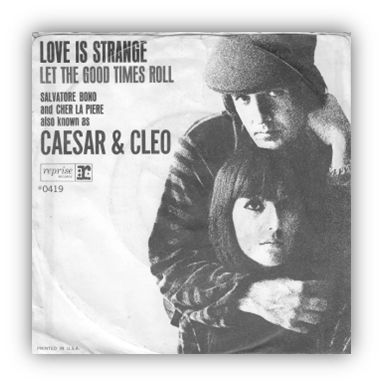
You’d think the Italians would have appreciated that.

On the other hand, you’ve seen the way he dressed.
Sonny was giving a voice to every unwashed hippie across America, a role just about as unconvincing as his lip-syncing. Unlike Dylan, nobody ever called Sonny Bono the voice of his generation.
“I Got You Babe” is a 7.
Meanwhile, in Song Of The Summer Land…

It’s “California Girls”
by The Beach Boys
(Seriously? That’s the artwork to “California Girls”?)
(Of the boys sitting down for a cappuccino in… that’s Paris, right?)

(Those mademoiselles aren’t even wearing French bikinis!)
Whilst music fans today struggle to think of a single nomination for Song Of The Summer 2025 that’s not completely “Ordinary,” way back in 1965:
They had better options.
They had The Beach Boys and their state of the nation address about… how the different girls of America dress.
Okay, that video’s a bit rubbish… here’s a better one from a few years later, even if it is ruined by Mike Love and his bushy beard.
Being Californian, The Beach Boys had an unfair advantage in the Song Of The Summer stakes, given that it’s basically summer all year ‘round down there.
The Beach Boys could write a song about girls wearing bikinis and guys waxing down their surfboards in the middle of January and get their inspiration from just looking out the window.
Here for example, is what I sincerely believe every Californian sees whenever they open the door in the morning:

Still, it’s quite mindboggling that the Beach Boys managed to score the Song Of The Summer three years in a row:
- “California Girls” in 1965
- “I Get Around” the year before that, and, in 1963…
- They had two! “Surfin’ U.S.A.” and “Surf City” for Jan & Dean, which they wrote!
For The Beach Boys were Californian.
Unlike their status as surfers – only one them, Dennis, could actually surf – nobody has ever questioned The Beach Boys Californian credentials.
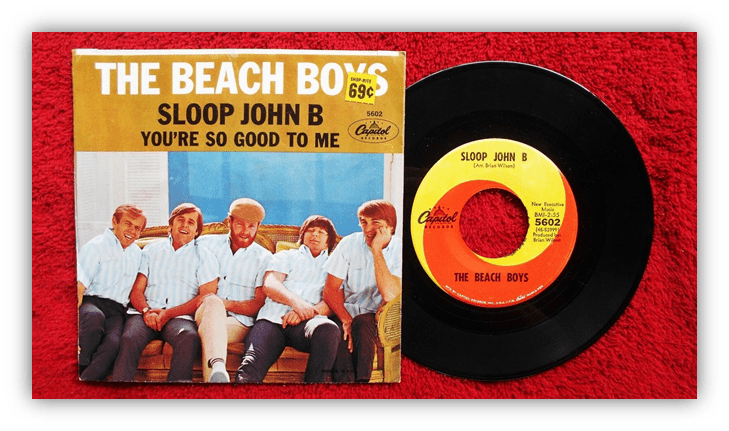
Even in those songs where California isn’t specifically mentioned, it’s impossible to imagine them coming from anywhere else.
The Beach Boys knew they were lucky to live in The Golden State; that’s why they invite everyone in America to join the surfin party in “Surfin’ U.S.A.”… in the Beach Boys’ world, they are even surfing in Manhattan! A similarly welcoming “everybody should be Californian” philosophy would inform their 1965 hit.
The Beach Boys had sung a lot about surfing by this point, and it was starting to get old. It was time to sing about the one thing that everybody wanted to hear about California, the thing that the Beach Boys were really singing about when they were singing about surfing:
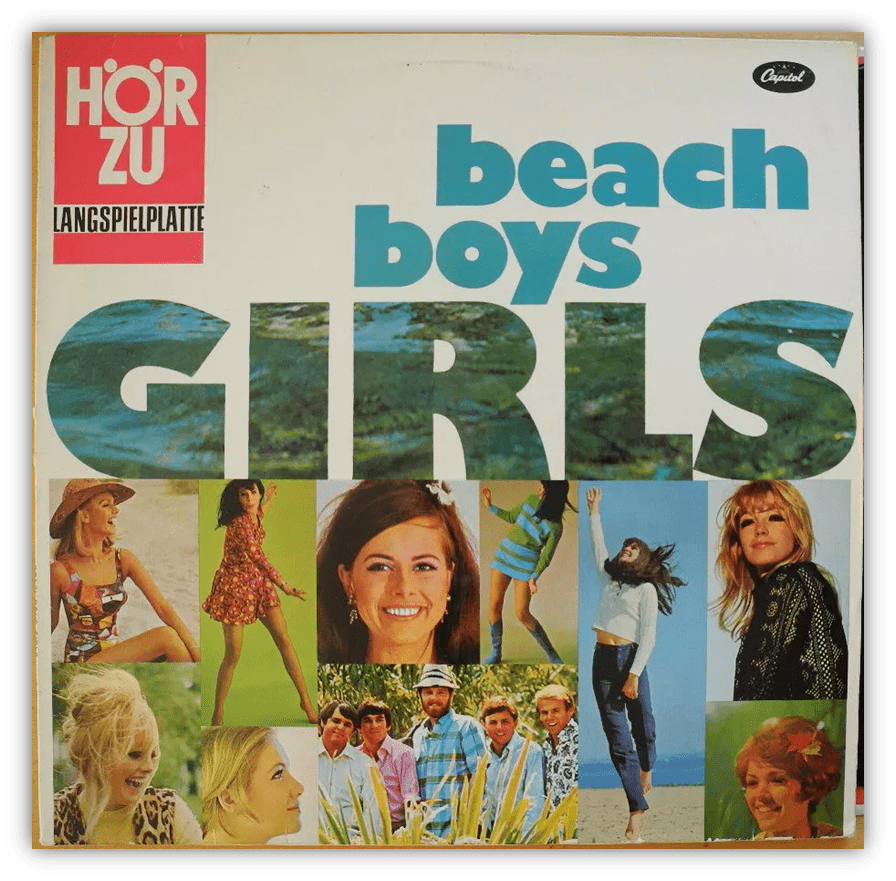
GIRLS!
And once again, The Beach Boys understand the importance of making everyone feel included, and so all the girls in America get a stereotypical shout-out:
- We learn that East Coast girls are hip.
- That Mike loves the way Southern girls talk.
- That Mid-West farmer’s daughters really make you feel alright.
- And that Northern girls keep their boyfriends warm at night…
It’s basically Ricky Nelson’s “Travelin’ Man,” but with far less travelling.
But all these girls, despite all their various qualities and undeniable charms, have to accept that they pale in comparison to the girls from California… they also have to accept that they are pale in comparison, since the West Coast has the sunshine and the girls all get so tanned.
Not everybody was happy about this.
Girls from states other than California heard “California Girls” and decided they weren’t going to take that lying down.
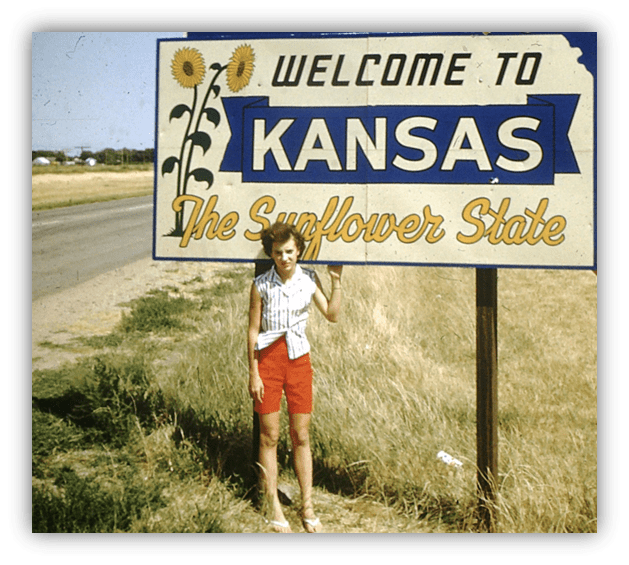
They started bugging Mike Love that they weren’t getting enough of Mike’s love. Decades later, Mike still felt as though he had to clarify what he meant:
“Some people misunderstood and thought we were saying that California girls were best.”
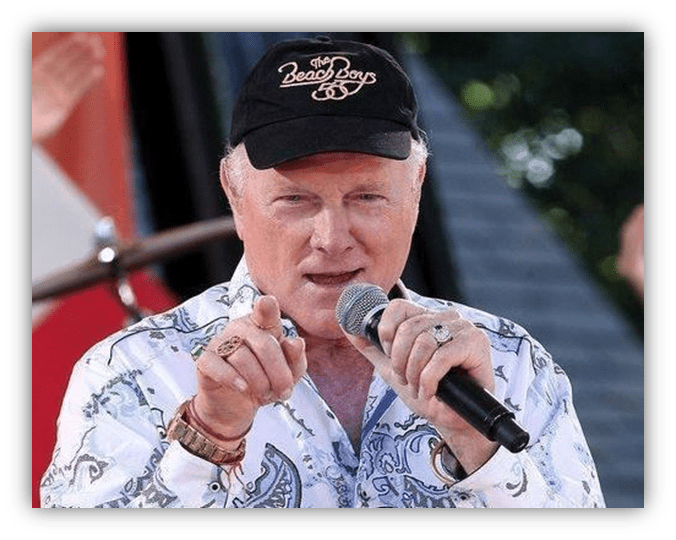
“What we were really saying if you listen or read the lyrics, we were appreciating the fact that even though we went all around the world we’d like to bring them all back to California with us.”
That way all the cute girls in the world can get tanned and wear French bikinis! Everybody wins!
The lyrics, “California Girl” theme and even the title – which was originally going to be “You’re Grass And I’m A Power Motor” – came late in proceedings, months after Brian had come up with the music.
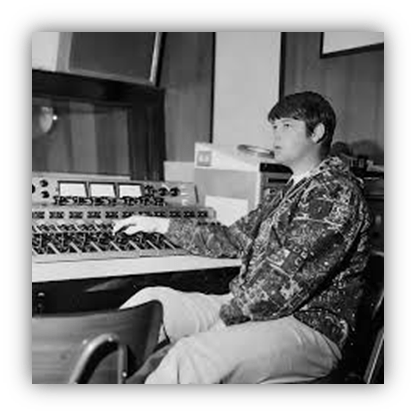
You have to remember that Brian was now deep into his staying-at-home-working-in-the-studio phase:
Whilst the rest of the boys were out on the road, being around this great big world, and seeing all kinds of girls.
Brian was also deep into his using LSD phase, which may explain that “You’re Grass And I’m A Power Motor” song title idea.
Legend has it that “California Girls” is the first song Brian Wilson wrote whilst on LSD. Not only that, it was the first time he’d taken LSD!
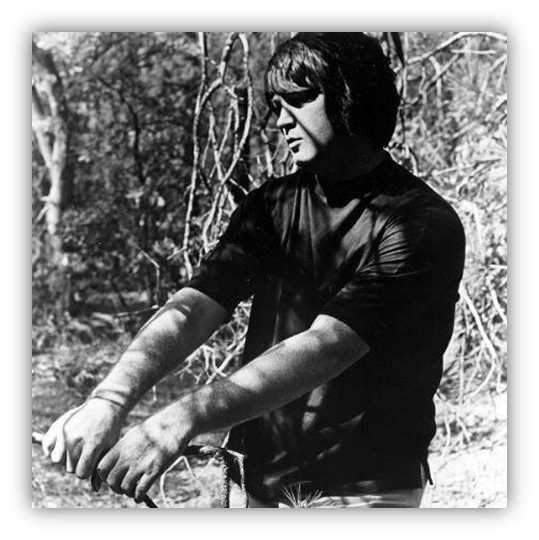
Brian wanted to take acid for purely professional reasons, as a tool to topple The Beatles. He probably didn’t need to take quite so much of it though: “a 125 microgram hit of liquid purple”, which, I am led to believe, is a lot.
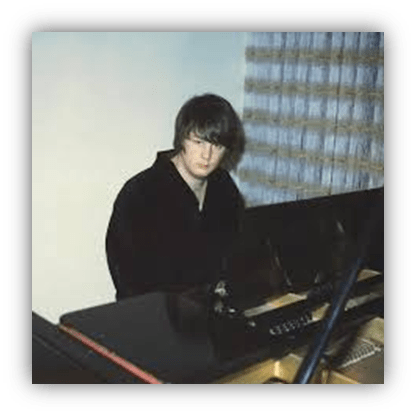
Soon he was seeing notes floating in the air. As he was coming down he found himself sitting down at the piano.
I feel quite confident that, if you polled 100 people and asked them what they thought the first Beach Boys song to be written on acid was, “California Girls” would not feature in the Top Ten responses. Personally, my vote would go for “Vegetables.”
Brian liked taking acid. It made him hear things. But it also seemed to worry him.
Soon Brian was asking one of the A&R guys at Capitol for validation that taking lots of acid was a good idea. That validation was not forthcoming:
“About a week later, Brian came back to my office and asked me to come down to Studio B. When we got down there, he said to me, ‘Let me play something that I hear when I’ve been on LSD.’ He sat down at the piano and played one note “
That incident appears to have happened a little bit later on. For “California Girls,” Brian was at least playing multiple notes.
Playing them “until I almost couldn’t hear what I was playing, and then I saw the melody hovering over the piano.”
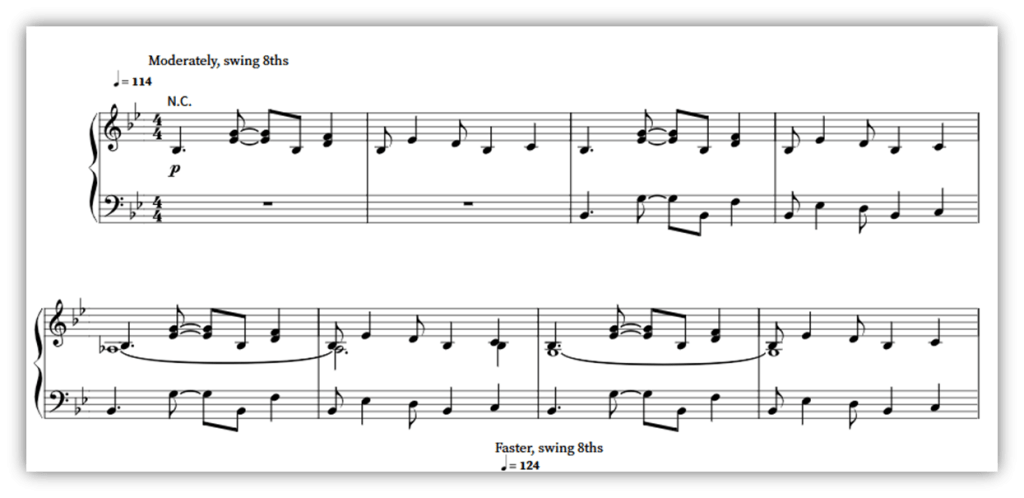
That melody was the “California Girls” intro.
Brian believes that the “California Girls” intro was the best thing he ever did.
It’s also the only part of “California Girls” that Brian thinks is really good, possibly because Mike hasn’t started singing yet. Sadly for Brian, most radio stations talked over that intro and television performances – such as the ones above – skipped it entirely. So here’s “California Girls” the way Brian meant it to be.
I always thought that intro sounded weirdly ahead of its time for the mid-60s.
I always thought that it sounded as though it belonged in the mid-80s, something by The Waterboys maybe… then, all of a sudden, I realized that it did… the intro to “California Girls” is basically:
The intro to the Dream Academy’s “Life In A Northern Town”!
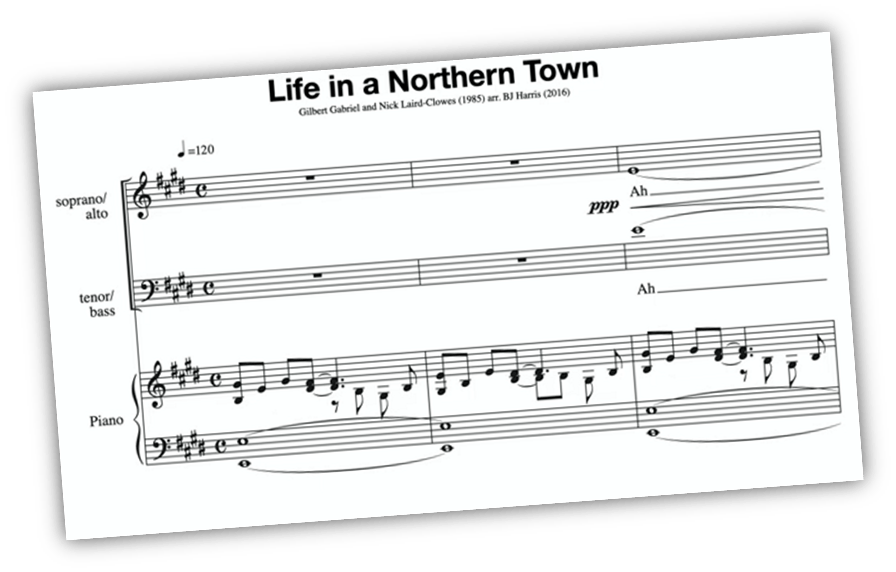
How did I not recognize this when I wrote about it a couple of months ago? “Life In A Northern Town” was a tribute to the mid-60s after all! It all makes sense!
Even though Mike wrote most of the lyrics, he didn’t write the chorus, the “I wish they all could be California Girls” part. That was Brian. So since we heard from Mike earlier trying to explain what the song is all about, let’s hear from Barmy Brian:
“The idea for ‘California Girls’ is that there’s this guy who thinks about girls all the time, so much that he starts to imagine all kinds.”
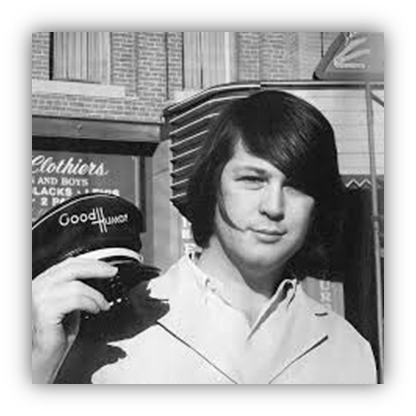
“But there’s only one kind he really wants, and that’s right there at home.”
Well, that’s nice, isn’t it? “California Girls” is a there’s-no-place-like-home kind of song. A how we should be happy with where we are and what we’ve got. That’s a weirdly trite and conservative message for a song where the best girls are the ones wearing the least clothes, but it’s kind of sweet all the same.
It’s lucky that Brian and Mike got “California Girls” out when they did.
The Summer of ‘65 may have been the last time for a while that California would be associated with girls in French bikinis. Within just a few short months California would become famous for very different fashion accessories. And even more LSD.
“California Girls” is a 9.
Meanwhile, in Greatest Song Of All Time Land…

It’s “Like A Rolling Stone”
by Bob Dylan
The Greatest Song Of All Time?
Well, yes… according to Acclaimed Music – the meta-critic list to end all meta-critic lists, anyway.
Also according to Rolling Stone – but obviously you’d expect them to like it – and Mojo, and:

NME, in what may have been the first ever 100 Best Singles Of All Time list way back in 1976. (Was it good or bad marketing to include the bulk of the list on the cover?)
Just in time for punk to come along and make the entire list irrelevant.
So, is “Like A Rolling Stone” truly the Greatest Song Of All Time, or is it just Bob Dylan playing random-work association games like he always does?
What is “Like A Rolling Stone” even about, anyway?
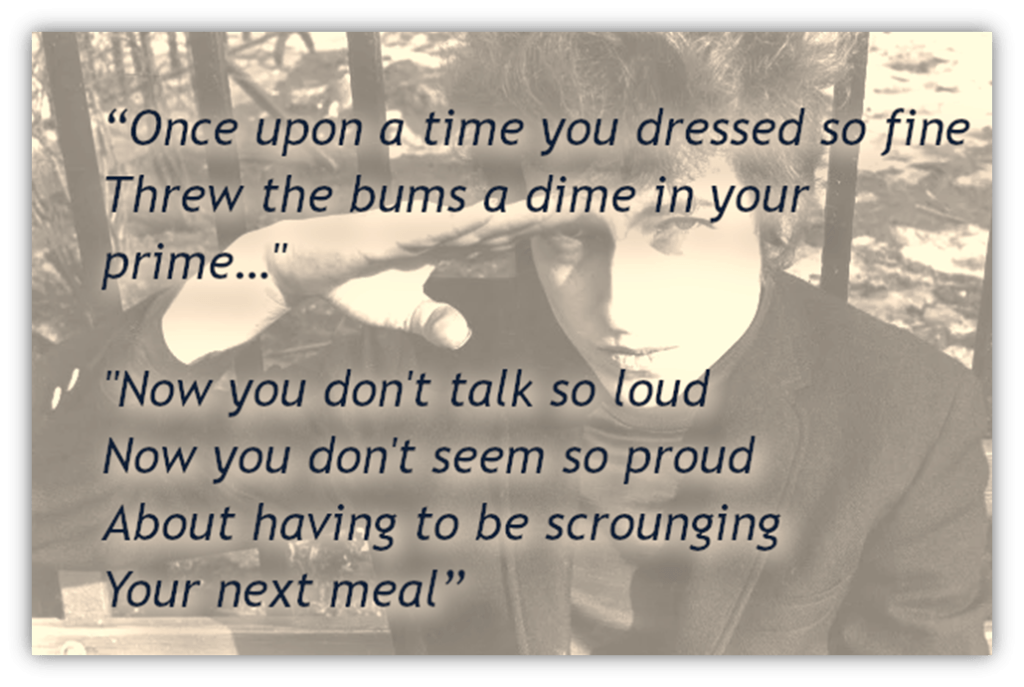
“Like A Rolling Stone” is about someone with a fancy privileged upbringing, losing everything, and ending up homeless on the streets. Staring into the vacuum of the eyes of a mystery tramp, saying “do yawanna… MAKE A DEEEAAALLL.”
Needless to say, this is not how they had expected their life to turn out.
Dylan, it appears, is not a fan of the establishment.
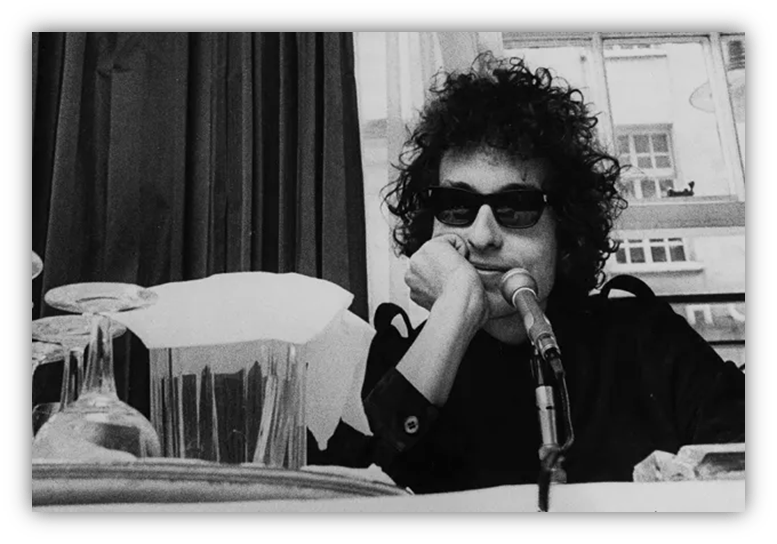
Whether out-of-touch journalists on “Ballad Of A Thin Man”, or like, the whole system, man, on “Times They Are A Changin,’” Dylan takes a lot of schadenfreude-y pleasure in watching the privileged fall.
So much pleasure that the original poem that “Like A Rolling Stone” was eventually whittled down to is alleged to have been 10 pages of, and here I quote Bob himself, “vomit.” Whoever “Like A Rolling Stone” was directed towards, Bob had a lot to get off his chest.
And he got it off his chest in a quintessentially Dylan manner, featuring references to historical figures:
“You used to be so amused
At Napoleon in rags and the language that he used”

Presumedly that “Napoleon in rags” line is a reference to the French Revolution, probably the most famous occasion in which the ruling classes met their downfall. Napoleon himself didn’t really do much in the revolution itself, he came along afterwards.
But it’s so hard to come up with something to rhyme with ‘Maximilien Robespierre…’

“Like A Rolling Stone” could have featured more historical references.
According to the scrawled notes that would later be auctioned off for millions of dollars by some guy Bob just casually handed them to, Dylan was trying to come up with an excuse to rhyme “no direction home, like a complete unknown” with “like a dog without a bone” and “like Al Capone.”

“Like A Rolling Stone” could have been titled “Like Al Capone”, and I can’t help but believe that the world would be a very different place if it had.
Those scribbled notes are a confounding mess… what was going on in Bob’s mind to include, not just a line about Al Capone, but a doodle of a chicken, a hat and…
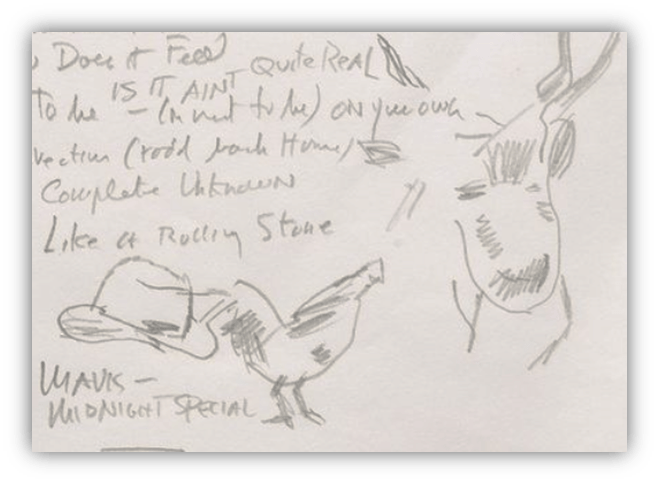
I think that’s a reindeer?
Not to mention whatever THIS was supposed to be.
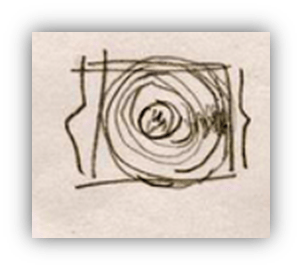
What IS that supposed to be? Is it a record player? A hurricane on a weather map on TV? Did he look out the window and see a vortex to another dimension?
Turns out that “you used to ride on a chrome horse with your diplomat”, could have been “man in black”, and it would have lost nothing in terms of comprehension, simply because the whole thing is barely comprehensible in the first place.
Looking at those notes, all the scribbling and scribbling out, you get the sense that Bob was second guessing himself a lot.
But apparently no… Bob was pumped up, giving himself high-fives, and thinking “I’m on fire, here!”
“The first two lines, which rhymed ‘kiddin’ you’ and ‘didn’t you,’ just about knocked me out, and later on, when I got to the jugglers and the chrome horse and the princess on the steeple, it all just about got to be too much.”
It sounds as though Bob was scared of just how good he was.
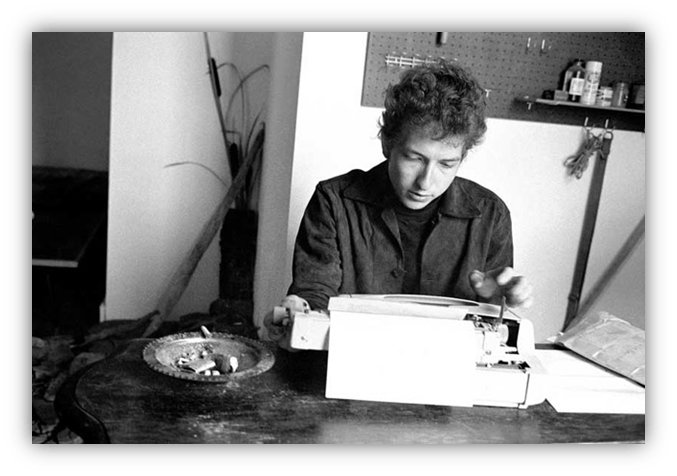
You can get a sense of Bob’s confidence from his flow, an avalanche of garbled words, a pregnant pause to take a breath, and then the rhyme.
Also from the “aaaah” at the beginning of each verse, the sound of Bob pumping himself up, the Dylan-version of shouting of “HERE WE GO!”
“aaaaaaaaaaaaaaaaaah, you’vegonetothefinestschools, alrightMissLonely!, Butyouknowyouonlyusedtoget… *deep breath*…

…JUICED IN IT!!!
Nobody’severtaughtyouhowtoliveoutonthestreetandnowyou’regonnahavetoget… * deep breath* USED TO IT!!!!!”
Bob Dylan is having fun with this!
So, The Greatest Song Of All Time is a meanspirited piece of schadenfreude and socialist tirade all in one? Why not?
It has to be about something, and that’s probably better than another soppy love song.
But revenge fantasies about the privileged ruling classes don’t usually make for good pop, not even when the artist is at the very peak of his voice-of-a-generation-imperial phase. Don’t forget that prior to “Like A Rolling Stone” Bob had only had one Top 40 hit and one top ten album.
He may have been inspiring Sonny & Cher, but he wasn’t exactly a chart phenomenon.
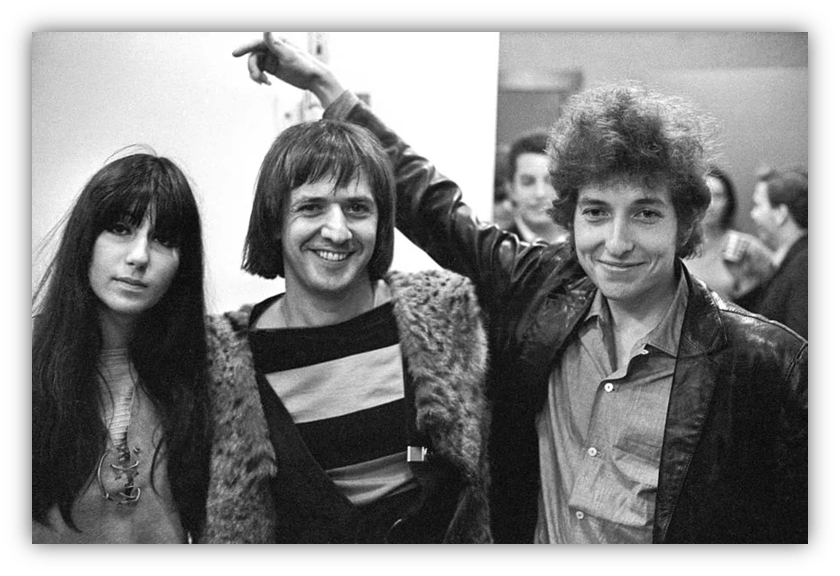
Fortunately Bob managed to cut that 10 pages down to “just” four verses. Which was still about two verses too long for the radio format of the time… or at least that was what Columbia feared: clearly they hadn’t taken into account the need for longer songs on the radio so that the DJ might have time to go to the toilet or smoke a joint.
That’s why Columbia originally sent out a much, much shorter version to radio, one that faded out halfway through the second chorus, just short of the three-minute mark.
The other half was the other side. This was weird for a rock’n’roll record, but it wasn’t entirely unprecedented. It’s just that most other hits where half the song was on one side of the record and the other half on the other were funk tracks. James Brown did it a lot. “Papa’s Got A Brand New Bag” for example, was split between Part 1 and Part 2.
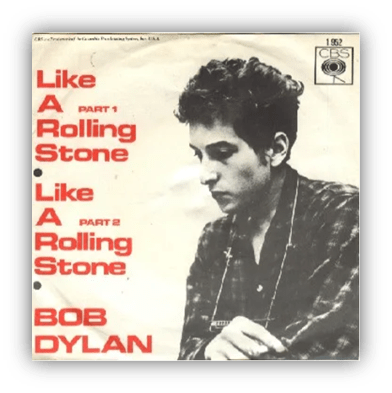
Fans started to call up radio stations to request the whole thing.
I can’t help but think that may have been the whole plan to begin with; to build hype and anticipation about the second half of the song.
Bob had written long songs before “Like A Rolling Stone.” “It’s Alright Ma, I’m Only Bleeding”, from Bringing It All Back Home earlier that year, was seven-and-a-half minutes long. “A Hard Rain’s Gonna Fall” was almost as long. But post-“Like A Rolling Stone”, things started to go crazy:
“Desolation Row” – written in the back of a taxi-cab, presumedly the driver was going the long way – went on for more than 11 minutes. That one is virtually nothing but historical and Biblical and pop culture references:
“Cinderella, she seems so easy, “It takes one to know one, ” she smiles, and puts her hands in her back pockets Bette Davis style, and in comes Romeo… Einstein, disguised as Robin Hood with his memories in a trunk…”
It all just about got to be too much.
The other legacy of “Like A Rolling Stone” is its association with the moment that “Dylan went electric.”
He went out there, at the Newport Folk Festival, carrying a Fender Stratocaster and wearing a leather jacket:
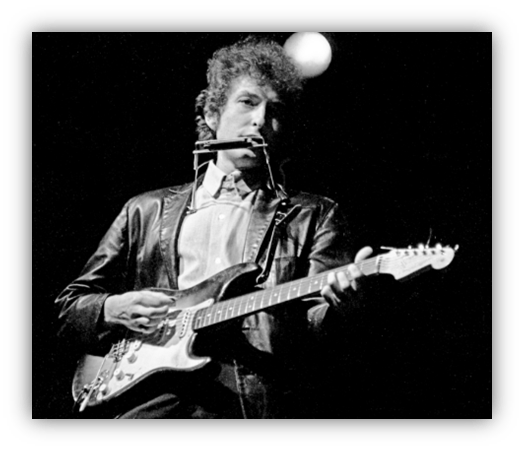
The latter of which almost feels like a parody of a rock’n’roller – and some members of the audience boo-ed.
Possibly this was because they didn’t like electric guitars, or possibly because Bob was clearly struggling with his band, although to be fair, they had only met the day before, and had only rehearsed once. One of the three songs they hadn’t even rehearsed at all.
Which begs the question: Why did he choose them?
Bob seems to have chosen them because they – they being the Paul Butterfield Blues Band – had inspired backstage fisticuffs just the day before. Fisticuffs between Alan Lomax, who was presenting the festival, and the band’s manager, over… Alan giving the band a rather lacklustre introduction:
“Us white cats always moved in, a little bit late, but tried to catch up…I understand that this present combination has not only caught up but passed the rest. That’s what I hear—I’m anxious to find out whether it’s true or not.”
You can understand why the band’s management may have felt a little nonplussed with that introduction. He may as well have said: “bit of a heads up… this could be some sorry shit.”
So, there were fisticuffs, there was rolling on the floor. And the next day Bob turns up with that very same band in tow. I’m not entirely convinced that “let’s see how many people I can piss off at once” wasn’t the whole extent of Bob’s thought process:
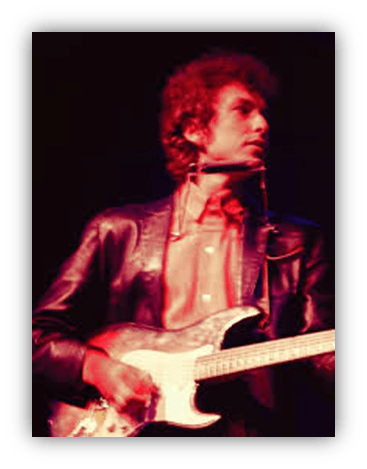
I mean, why make your electric live debut at the Newport FOLK Festival? That was just asking for trouble!
And so there was boo-ing. Not a lot perhaps, but some.
It was all such a long time ago, and nobody really knows what happened. Rumours abounded. One about folk-protest-singer icon Pete Seeger marching off to kill the power by attacking the electric cable with an axe. Which strikes me as a terribly dangerous idea.

Good thing it didn’t actually happen then. Pete said he’d like to, but he didn’t. Sensible man.
And the reason why Pete Singer was considering such a radical move? It wasn’t because he was anti-electric guitars, it was the music was so loud that nobody could understand the words. After all, words are a key part of the Bob Dylan package.
My favourite takeaway from the postcard that Pete Seeger sent to Bob decades later to clarify things: he signs off with a banjo!
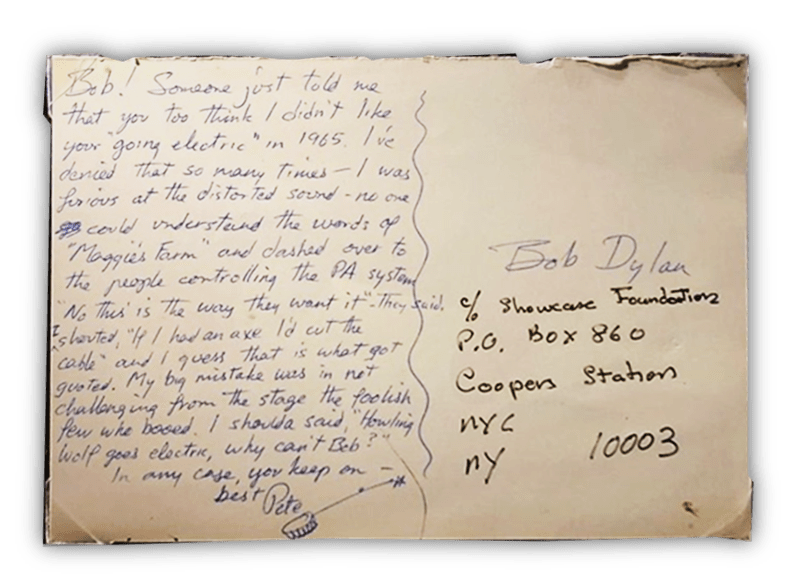
Dylan had gone electric before. Dylan had rocked out before.
Back in high school, back in Hibbing, Minnesota, he played a talent show rockin’ out to Danny & The Junior’s “Rock’n’Roll Is Here To Stay” so hard that the principal cut the microphone.

He was too darn loud.
I wonder if Bob was feeling a sense of déjà vu? I wonder if “Dylan going electric” was Bob’s way of proving that Danny & The Juniors had been right after all, and rock’n’roll was here to stay? Songs like “Like A Rolling Stone” are part of the reason why.
Bob Dylan had the pop music game in such a Beatles-like chokehold in the summer of 1965 that I could justifiably have written a column on The Byrds’ “Mr Tamborine Man” instead. Maybe I should have… maybe you wished they all could have been California sooooonnnnnggggsssss.
But I’ll save my Byrds’ column for a record they actually played on…
“Mr Tamborine Man” is a 9, though.
“Like A Rolling Stone” – which, for the record, only mentions the word “babe” once: “you better take your diamond ring, you better pawn it… BAAAABBBEEEEE” – may or may not be The Greatest Song Of All Time…
But it’s still a 10.
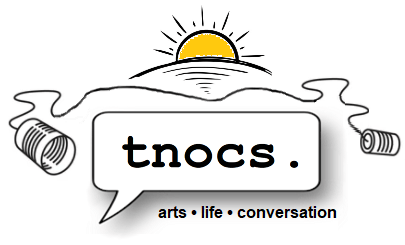



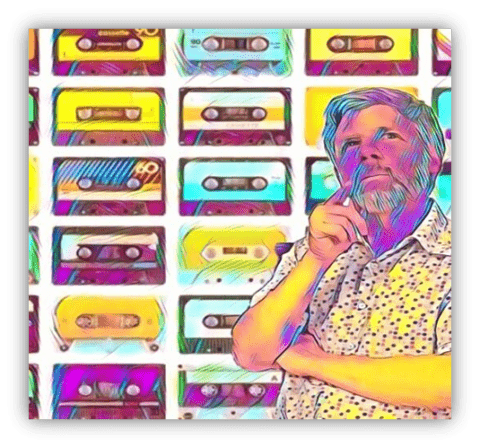



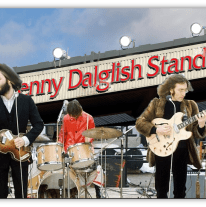
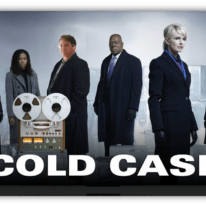
And presenting the Official It’s The Hits Of August-ish 1965 Playlist!
From “I’ve Got You Babe” to “It Ain’t Me Babe”, the latter being The Turtles’ cover of the Dylan classic, and the most likely candidate for the “babe” song that Sonny heard every time he turned on the radio!
https://open.spotify.com/playlist/1N9S0ISCgC26A9Peesu8LZ?si=4aa58df79d8c461f
On the country side of the tracks, Norma Jean warns women away from an untrustworthy man…
https://www.youtube.com/watch?v=v8OFOLLxeHg
I just did a double take wondering if Marilyn had a pre-fame / pre-name change country period that I wasnt aware of. The untrustworthy men probably fits right into her life.
Norma Jean Beasler was a regular on The Porter Wagoner Show in the 1960s. She was replaced by Dolly Parton when she left the show after getting married. She was prolific during that time, recording 18 solo albums in 10 years from 1964-1973, plus the collaborative concept album “A Game of Triangles” with Bobby Bare and Liz Anderson. She continued touring and occasionally recording for decades. Her last album came in 2014. She’s still alive, so it’s possible she could record again, but I’d guess she’s done.
Thoroughly entertaining read.
A bit late but I’ve remembered one for Chuck’s piece on songs that have been overplayed: I Got You Babe.
Groundhog Day is a great film but it does mean I never want to hear this song again. Unfortunately it seems that it had the opposite effect on others. How can someone watch Groundhog Day and think it needs more airtime?!
Like A Rolling Stone is a 10. Though the bootleg series ‘Live At The Royal Albert Hall’ (recorded 200 miles from there at the Manchester Free Trade Hall but who cares about facts?) version is a 11. The one where an audience member called him Judas so he told the band to ‘play it fucking loud’. That one is a thunderous force of nature.
I enjoyed A Complete Unknown. I don’t mind the artistic licence in moving the Judas moment from
LondonManchester to Newport. Its just that the version the band then play sounded so weak in comparison.Best moment of the week though; ‘You’re Grass And I’m A Power Motor”. Wonderful stuff.
“I Got You Babe” is cute in it’s silliness. And that oboe.
“California Girls” is a good song, but the intro is absolutely the best part of it. I’d never heard the into’s origin story before.
“Like a Rolling Stone” is fine I suppose, but I usually turn it when it comes on. Someday Bob Dylan might click with me.
Two contenders for top 10 of all time, and one “meh” for me. I could never abide Sonny’s voice. But the “Line of the Article” is “Barry sounded, and looked, as though he was channeling the pain of a construction worker who had just dropped a wrench on his toe.” Fabulous.
Can’t believe that I left out “California Girls” from my top 60 songs of 1965 list I had in February. It was a genuine oversight. That was a definite 10.
And I know I’ll probably get hisses from some here, but I’ve ranked “I Got You, Babe” slightly higher than “Like a Rolling Stone.” I blame it in part on growing up in the 1970s and hearing Sonny and Cher sing it as their closing song on their variety show every week.
[…] The Bee Gees have a lot in common with one of our featured artists from last week: The Beach Boys. […]